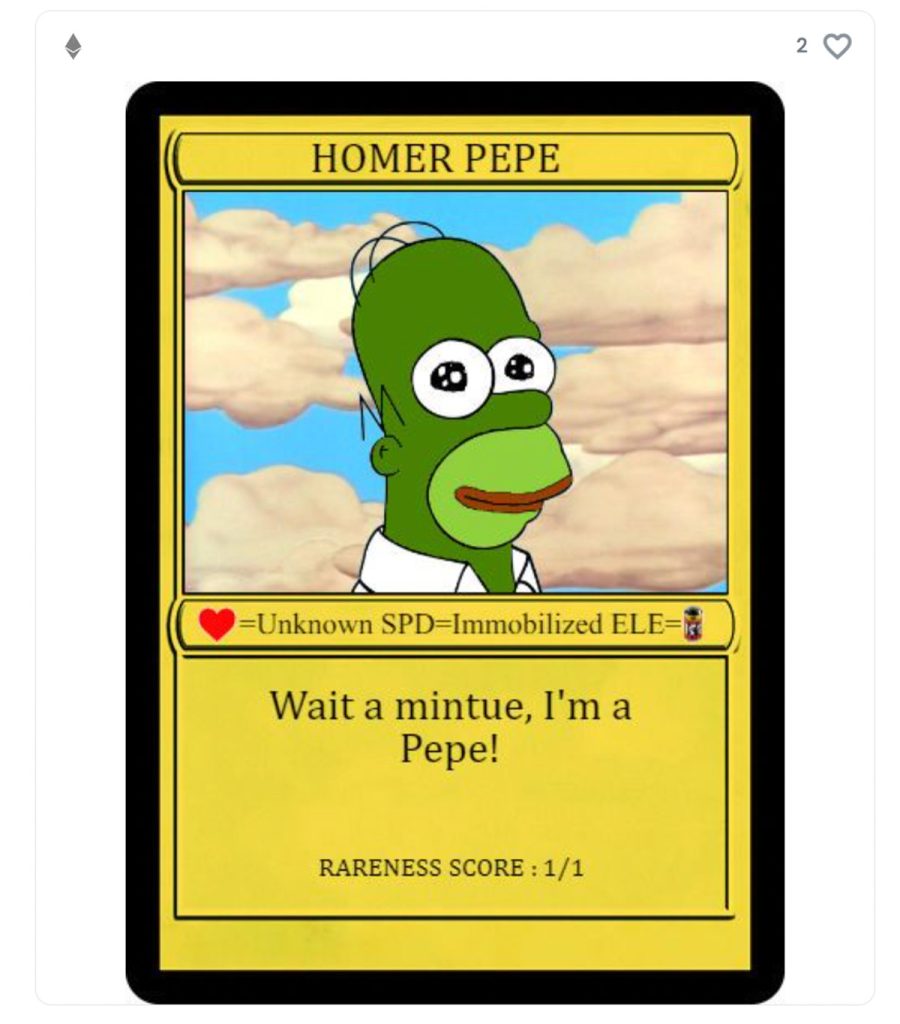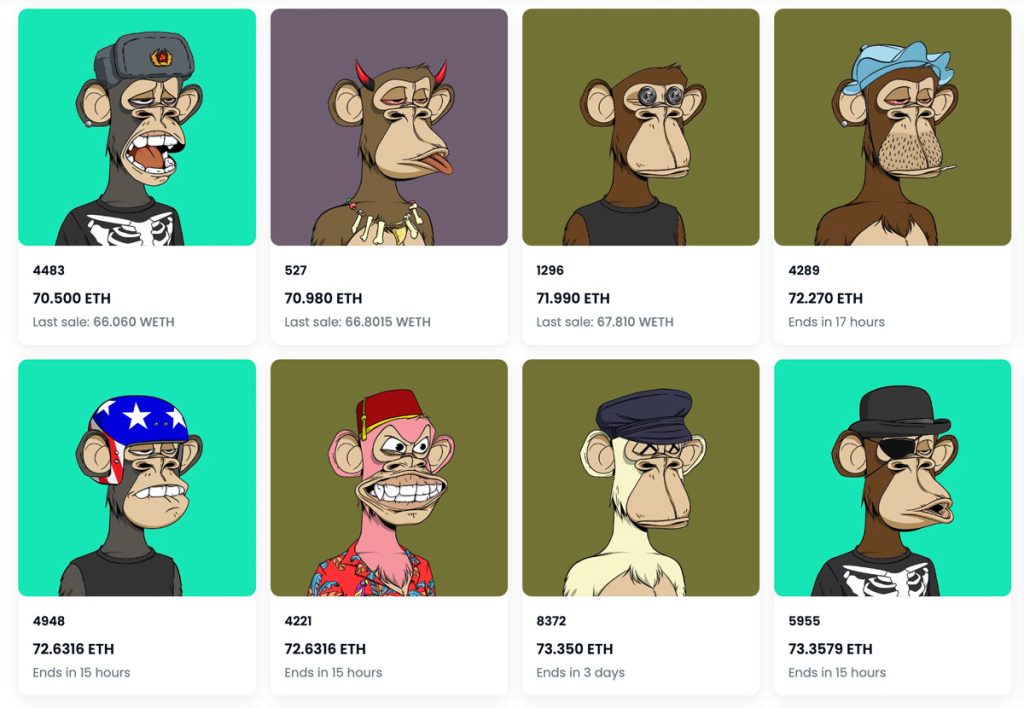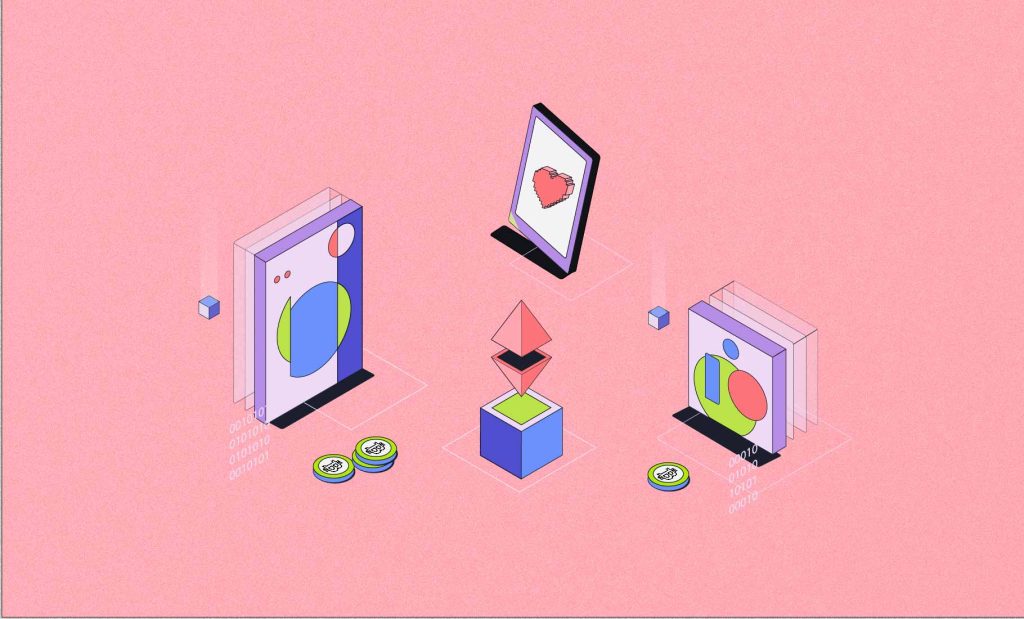They say that art knows no boundaries. And blockchain art proves it. Not only does blockchain art expand the geographical reach of an artwork, but it also goes beyond the realm of digital art. Blockchain art and digital art do share some similarities, but one of the main things to separate them is the reliance on a distributed public ledger in the former.
What does the rise of blockchain art mean for artists, art connoisseurs, collectors, and the future of art? You’ll find all the answers right here, but let’s start with the basics.
What is blockchain art?
Blockchain art, as the name suggests, refers to artwork that is stored on the blockchain in the form of Non-Fungible Tokens (NFTs). The non-fungible (meaning inimitable) nature of these tokens means that there is no other identical token in the world. This type of blockchain-based art is also sometimes called crypto art.
Users need to mint such NFTs to view, hear, or experience the artwork. Buyers and sellers on the blockchain can trade the art using crypto. The buyer acquires exclusive access to a piece, but the copyright and reproduction rights remain with the artist. Unlike regular digital art, the blockchain-based counterpart cannot be duplicated, so the rights of creators are better protected.
Anything from music albums and paintings to awards and memorabilia can be rendered immutable via blockchains. Just like traditional art, the value of such items is linked to three factors:
- Who the creator is,
- How rare the art is, and
- The demand for the artwork in the market.
The rising popularity of blockchain art gave birth to several NFT marketplaces like OpenSea, Art Blocks, and Rarible. You can use these platforms to acquire ownership of a piece of art.
Famous examples of blockchain art
There are many blockchain artworks and artists in the decentralized age. Some of the most famous blockchain art out there are discussed below.
Nyan Cat
Created by Chris Torres in 2011, Nyan Cat is a popular animation that was turned into a meme and eventually an NFT. Its NFT avatar made its public debut on the occasion of its 10-year anniversary in the midst of the NFT boom.

The Nyan Cat NFT was sold for 300 ETH on 19 February 2021.
Homer Pepe
Homer Pepe is a popular NFT that displays a morph between Pepe the Frog and Homer Simpson. Pepe the Frog is one of the oldest internet memes and also one of the oldest NFTs. And Homer, from The Simpsons, is one of the greatest comedic animated characters. The amalgamation of these two iconic internet characters formed the Homer Pepe NFT.

The Homer Pepe NFT was sold for 205 ETH in March 2021
Bored Ape
Bored Ape Yacht Club (BAYC), or Bored Ape, is one of the most well-known crypto art collections. Made up of 10,000 cartoon ape NFTs, Bored Ape has become one of the best-selling collections in the crypto ecosystem.

The popularity of BAYC NFTs has to do with the fact that it has received several celebrity endorsements, including from the likes of Justin Bieber, Jimmy Fallon, Snoop Dogg, and Eminem.
The most expensive NFT from the collection was sold for $2.7 million on OpenSea in October 2021.
Why are artists turning to blockchains and NFTs?
Before blockchain technology existed, the idea of one-of-a-kind digital art was hard to imagine. Because it is so easy to duplicate a piece of digital art and have multiple people own a copy. This easy duplicability means the rarity quotient takes a hit, and that adversely impacts the value of the artwork. So, the immutability of blockchains and the non-fungibility of NFTs translates into better protection of artists’ interests. Blockchain art, thus, solves one of the biggest problems that digital artists face: duplication.
Another fundamental advantage is that it grants them a global platform where anyone can buy their artwork.
Additionally, blockchain artists can fix the amount they would like to receive as royalty in the smart contract. Whenever the NFT is minted, the amount is credited to them. This includes primary as well as secondary sales (the reselling that goes on after the first sale—the primary sale). So, each time the work is sold, the creator gets a cut—unlike the one-time transactions of traditional sales.
The rise of blockchain art
Quantum is considered the first NFT ever created. It was created by digital artist Kevin McCoy and his wife, Jennifer McCoy. It was minted on the pre-Ethereum Namecoin, which was forked out of Bitcoin in 2014. However, Quantum remained unknown to most for the next seven years.
The year 2021 will forever be known as the year NFTs became mainstream. The sale of two NFTs, in particular, changed the course of blockchain art history.
1. Beeple’s Everyday: The First 5,000 Days artwork
Perhaps one of the most significant NFTs to be sold so far is Beeple’s Everyday: The First 5,000 Days. Beeple, whose real name is Mike Winkelmann, is a digital artist. In 2007, he pledged to create one piece of art every single day. Over the next couple of years, Beeple created 5,000 artworks, which he then sold in the form of NFTs. Those 5,000 days of work earned him $69 million on 11 March 2021! Not a bad deal, eh?
Every day holds the record for the second most expensive NFT ever sold. Besides, it was auctioned at Christie’s, one of the largest auction houses in the world. That makes it the first NFT to be sold at a major auction house. It was also the first time an auction house had accepted crypto (Ether, in this case) as a form of payment.
2. Jack Dorsey’s tweet
Another NFT that boosted the rise of crypto art is one based on the world’s first-ever tweet. Founder Jack Dorsey put out a tweet on 22 March 2006 that read, “just setting up my twttr.” In 2021, he converted the tweet into an NFT and put it up for auction. The NFT was bought for $2.9 million by crypto entrepreneur Sina Estavi.
Although Dorsey’s tweet was significantly lower in value compared to Beeple’s art, it did play a significant role in redefining the possibilities of blockchain art. The sale translated into a rise in the number of mentions of blockchain art outside the crypto space. The number of searches for “blockchain art” on Google keyword trends, for instance, spiked in April 2021, a month after Dorsey’s tweet NFT was sold. Several artists, celebrities, and a wide range of luxury brands, too, took inspiration and hopped onto the NFT bandwagon.
While 2021 was a great year for blockchain art, the following year couldn’t quite keep up. The crypto winter took a severe toll on the NFT ecosystem and the broader crypto market.
Despite the setback, going by the numbers of the past two years, the NFT marketplace, where the wares are mostly blockchain art, has seen massive growth. The global market for NFTs has generated over $23 billion in trading volume in 2021, according to the crypto data analysis platform DappRadar. That’s a 230x increase from 2020.
Conclusion
Blockchain art is undoubtedly one of the best real-world use cases of the decentralized world of blockchains. It has changed not only the way people perceive art but also the relationship between the artist and the art owner. It gives both parties a better experience.
With all of these pluses, it’s understandable that the entertainment industry has been trying to make forays into the Web 3.0 space. Thanks to this and the high demand for media products whether music or movies blockchain art could be expected to keep growing.
FAQs
Why is blockchain gaining popularity?
The combination of security, transparency, efficiency, and the potential for disruptive innovation has contributed to the growing popularity of blockchain technology across various industries and sectors.
What is the future of art in blockchain?
The future of art in blockchain holds great promise for increasing transparency, accessibility, and efficiency in the art market. However, it will also require careful consideration of legal and ethical issues, as well as addressing technical and environmental challenges associated with blockchain technology.
What is the blockchain art?
Blockchain art has gained significant attention in recent years, with artists from various disciplines, including visual artists, musicians, and even meme creators, participating in this innovative space.
What is the rise of blockchain technology?
The rise of blockchain technology has been marked by innovation, increased adoption, and a growing awareness of its potential across various industries. While challenges and regulatory issues persist, the technology has already had a transformative impact and is likely to play a significant role in the future of finance, business, and technology.








